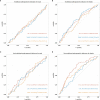Visceral adiposity measures are strongly associated with cardiovascular disease among female participants in Southwest China: A population-based prospective study
- PMID: 36157470
- PMCID: PMC9493204
- DOI: 10.3389/fendo.2022.969753
Visceral adiposity measures are strongly associated with cardiovascular disease among female participants in Southwest China: A population-based prospective study
Abstract
Background and aims: Controversy remains regarding the prediction effects of different adiposity measure indicators for the risk of cardiovascular disease (CVD). Our study aimed to assess the associations of three traditional anthropometric indicators, namely, waist circumference (WC), waist-to-height ratio (WHtR), and body mass index (BMI) as well as three non-traditional anthropometric indicators, namely, the Chinese visceral adiposity index (CVAI), lipid accumulation product (LAP), and body shape index (ABSI), with the risk of CVD among Southwest Chinese population.
Methods: Our study was based on the Guizhou Population Health Cohort Study (GPHCS) conducted from 2010 to 2020. A total of 9,280 participants were recruited from 12 areas in Guizhou Province, China, from November 2010 to December 2012, and followed up for major chronic diseases until December 2020. A total of 7,837 individuals with valid data were included in this analysis. The gender-specific associations of WC, WHtR, BMI, CVAI, LAP, and ABSI with CVD were evaluated using Cox proportional hazards models. Receiver operating characteristic (ROC) curve analysis was used to estimate the prediction powers of different indicators for CVD.
Results: No association of six indicators with CVD was observed among male participants. Female participants with either WC-based central obesity (HR: 1.82, 95% CI: 1.12-2.97) or WHtR-based central obesity (HR: 1.68, 95% CI: 1.07-2.64) had a higher risk of CVD, after adjusted for age, area, ethnic group, smoking, alcohol drinking, MET, previous history of diabetes, hypertension and dyslipidemia, medication use, and nutraceutical intake. Compared with female participants in the lowest quartile (Q1), those in the highest quartile (Q4) of WHtR (HR: 2.24, 95% CI: 1.17-4.27), CVAI (HR: 3.98, 95% CI: 1.87-8.49), and ABSI (HR: 1.94, 95% CI: 1.06-3.52) had an increased risk for incident CVD. CAVI showed the maximum predictive power of CVD with the biggest AUC of 0.687 (95% CI: 0.654-0.720) compared to other indicators in female participants.
Conclusions: Visceral adiposity measures, especially CVAI, are stronger predictive indicators of CVD among female and not male participants in Southwest China. Different anthropometric indexes need to be combined to comprehensively assess health risks.
Keywords: anthropometric; cardiovascular disease; cohort study; southwest China; visceral adiposity.
Copyright © 2022 Wang, Zhao, Chen, Yao, Zhang, Wang, Liu and Fu.
Conflict of interest statement
The authors declare that the research was conducted in the absence of any commercial or financial relationships that could be construed as a potential conflict of interest.
Figures



Similar articles
-
The Chinese visceral adiposity index: a novel indicator more closely related to cardiovascular disease than other abdominal obesity indices among postmenopausal women.J Transl Med. 2024 Sep 23;22(1):855. doi: 10.1186/s12967-024-05665-y. J Transl Med. 2024. PMID: 39313824 Free PMC article.
-
Dose-response association between Chinese visceral adiposity index and cardiovascular disease: a national prospective cohort study.Front Endocrinol (Lausanne). 2024 Apr 18;15:1284144. doi: 10.3389/fendo.2024.1284144. eCollection 2024. Front Endocrinol (Lausanne). 2024. PMID: 38699393 Free PMC article.
-
Comparison of obesity indicators for predicting cardiovascular risk factors and multimorbidity among the Chinese population based on ROC analysis.Sci Rep. 2024 Sep 9;14(1):20942. doi: 10.1038/s41598-024-71914-1. Sci Rep. 2024. PMID: 39251694 Free PMC article.
-
Associations of general and central adiposity with hypertension and cardiovascular disease among South Asian populations: a systematic review and meta-analysis.BMJ Open. 2023 Dec 18;13(12):e074050. doi: 10.1136/bmjopen-2023-074050. BMJ Open. 2023. PMID: 38110373 Free PMC article.
-
Waist to height ratio as a simple tool for predicting mortality: a systematic review and meta-analysis.Int J Obes (Lond). 2023 Dec;47(12):1286-1301. doi: 10.1038/s41366-023-01388-0. Epub 2023 Sep 28. Int J Obes (Lond). 2023. PMID: 37770574
Cited by
-
The association of changes in the Chinese visceral adiposity index and cardiometabolic diseases: a cohort study.Diabetol Metab Syndr. 2024 Sep 14;16(1):228. doi: 10.1186/s13098-024-01460-3. Diabetol Metab Syndr. 2024. PMID: 39272152 Free PMC article.
-
Comparison of Several Adiposity Indexes in Predicting Hypertension among Chinese Adults: Data from China Nutrition and Health Surveillance (2015-2017).Nutrients. 2023 Apr 29;15(9):2146. doi: 10.3390/nu15092146. Nutrients. 2023. PMID: 37432280 Free PMC article.
-
Association of the time course of Chinese visceral adiposity index accumulation with cardiovascular events in patients with hypertension.Lipids Health Dis. 2023 Jul 1;22(1):90. doi: 10.1186/s12944-023-01852-w. Lipids Health Dis. 2023. PMID: 37391821 Free PMC article.
-
The Chinese visceral adiposity index: a novel indicator more closely related to cardiovascular disease than other abdominal obesity indices among postmenopausal women.J Transl Med. 2024 Sep 23;22(1):855. doi: 10.1186/s12967-024-05665-y. J Transl Med. 2024. PMID: 39313824 Free PMC article.
-
Body Composition Evaluation and Clinical Markers of Cardiometabolic Risk in Patients with Phenylketonuria.Nutrients. 2023 Dec 18;15(24):5133. doi: 10.3390/nu15245133. Nutrients. 2023. PMID: 38140392 Free PMC article. Review.
References
-
- James SLG, Abate D, Abate KH, Abay SM, Abbafati C, Abbasi N, et al. Global, regional, and national incidence, prevalence, and years lived with disability for 354 diseases and injuries for 195 countries and territories, 1990-2017: a systematic analysis for the global burden of disease study 2017. Lancet (London England) (2018) 392(10159):1789–858. doi: 10.1016/S0140-6736(18)32279-7 - DOI - PMC - PubMed
-
- Li J, Li X, Wang Q, Hu S, Wang Y, Masoudi FA, et al. ST-segment elevation myocardial infarction in China from 2001 to 2011 (the China PEACE-retrospective acute myocardial infarction study): a retrospective analysis of hospital data. Lancet (London England) (2015) 385(9966):441–51. doi: 10.1016/S0140-6736(14)60921-1 - DOI - PMC - PubMed
Publication types
MeSH terms
LinkOut - more resources
Full Text Sources
Research Materials
Miscellaneous

